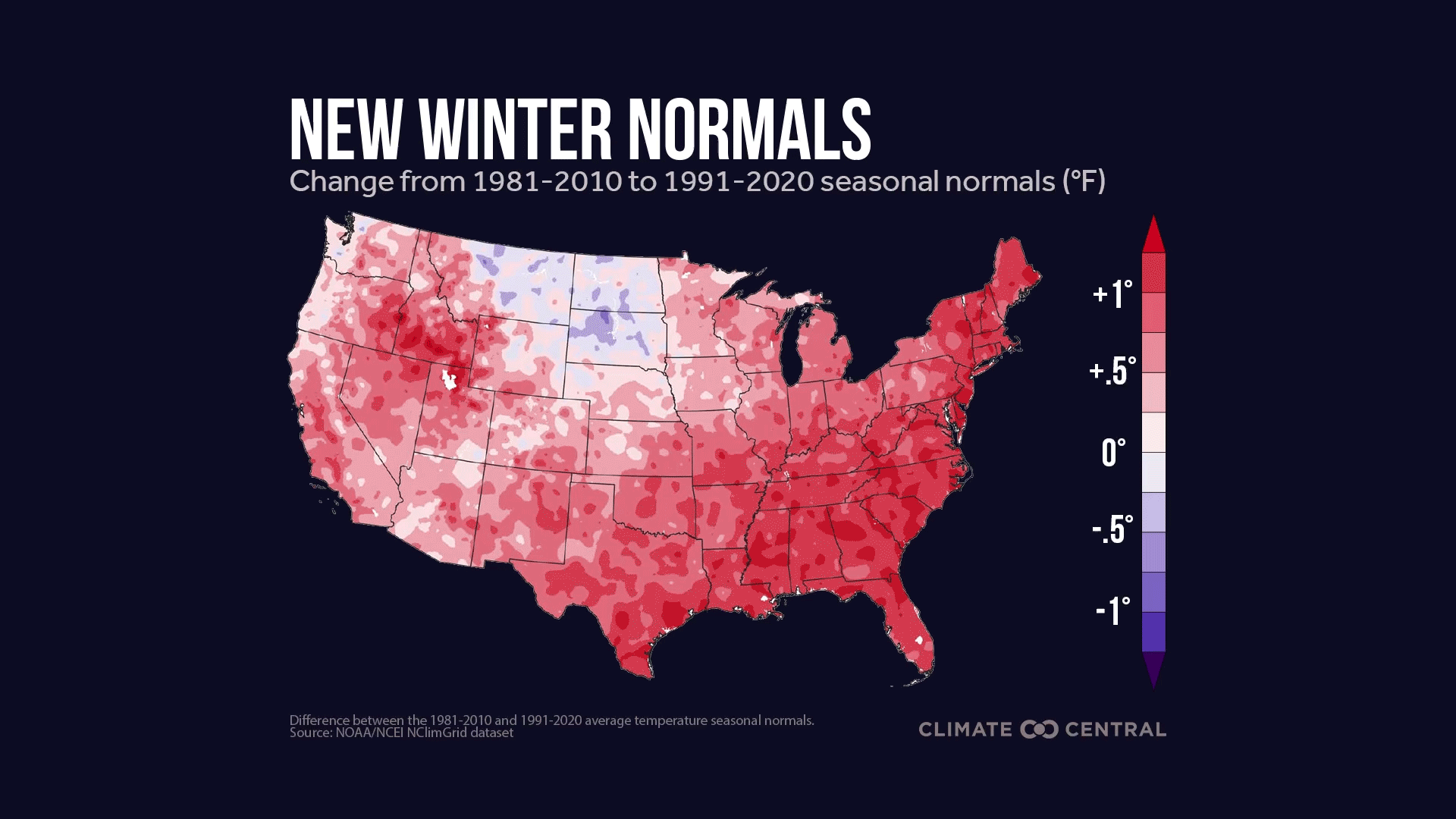KEY CONCEPTS
Climate normals are 30-year averages of weather data that provide a baseline for comparing current conditions in each season and region of the country.
Here, we look at the change in seasonal normal temperatures between the 1991-2020 and 1981-2010 periods.
Despite regional variation, when averaged across the contiguous U.S., every season was 0.4 to 0.7 °F warmer during 1991-2020 than during the previous 30-year period (1981-2010).
Winter was the season with the largest and most widespread rise in normal temperatures of well over 1 °F within nearly every region.
The largest increase in normal temperatures for each season ranged from +1 °F (fall) to +1.4 °F (winter), and occurred at locations in California, Idaho, New Mexico, Texas, and Utah.
A warming baseline
Climate normals average 30 years of weather data, providing baseline conditions for each season and region of the country.
NOAA’s U.S. climate normals for 1991–2020 provide the most recent baseline for comparing current weather, and for understanding our changing climate.
We previously covered the annual average warming reflected in the updated 1991–2020 normals. Here, we’re taking a closer look at the change in seasonal normals.
Shifting seasons across the country
Despite regional variation, when averaged across the contiguous U.S., every season was 0.4 to 0.7 °F warmer during 1991-2020 than during the previous 30-year period (1981-2010).
Winter was the season with the largest and most widespread rise in normal temperatures of over 1 °F within nearly every region.
One exception was the north-central region. In some parts of this region, the 1991-2020 winter or spring normal temperatures were up to 0.7 °F cooler.
Local change in seasonal normals
For a closer look at changes within each region, Climate Central charted the difference between 1981-2010 and 1991-2020 normals for each season in 242 locations across the contiguous U.S.
Winter normals increased by 0.7 °F on average. Jackson, Idaho saw the largest increase (+1.4 °F).
Spring normals increased by 0.4 °F on average, with El Paso, Texas topping the list (+1.1 °F).
Summer normals also increased by 0.4 °F on average. Odessa and El Paso, Texas as well as Las Cruces, N.M. have all seen normal summer temperatures rise by +1.2 °F.
Fall normals increased by 0.5 °F on average, and by +1 °F in Salt Lake City, Utah and Fresno, Calif.
Normal temperatures in every season and nearly every region of the country are rising, decade by decade. Comparing the 1991-2020 normals to the 20th century average highlights how much warmer “normal” conditions have become with human-caused climate change.
POTENTIAL LOCAL STORY ANGLES
What do climate normals mean to my community?
Climate Normals aren’t just used to describe weather—they’re used to inform decisions across a range of sectors. Consider interviewing professionals from industries that use climate normals, such as: growers, municipal officials, city planners, electrical companies, construction companies and insurance groups.
Where can I find more information on the new climate normals?
On the NCEI website, NOAA provides national maps for other temperature and precipitation metrics which you can customize by month or season. You can also create local charts, choosing your own parameter and time scale.
LOCAL EXPERTS
The SciLine service, 500 Women Scientists or the press offices of local universities may be able to connect you with local scientists who have expertise on CHANGE and climate change. The American Association of State Climatologists is a professional scientific organization composed of all 50 state climatologists.
NATIONAL EXPERTS
Theresa Crimmins, Ph.D., Director
USA National Phenology Network and Research Professor
School of Renewable Natural Resources, University of Arizona
Contact: theresa@usanpn.orgAlyssa Rosemartin, Partner and Application Specialist
USA National Phenology Network
School of Natural Resources and the Environment, University of Arizona
Contact: alyssa@usanpn.org
*Available for interviews in SpanishMichael A. Palecki, Ph.D., Physical Scientist
NOAA’s National Centers for Environmental Information
Media Contact: John Bateman, john.jones-bateman@noaa.govBecky Bolinger, Ph.D., Assistant State Climatologist
Colorado Climate Center
Contact: Becky.Bolinger@colostate.edu
METHODOLOGY
Seasonal average temperature normals for the 1981-2010 and 1991-2020 periods were calculated for the contiguous United States using the NOAA/NCEI nclimgrid gridded dataset. Data was extracted from the grid cell that contains the weather station used in each market. Station-specific normals may vary from the gridded normals calculated in this analysis.
